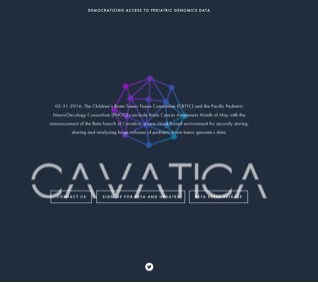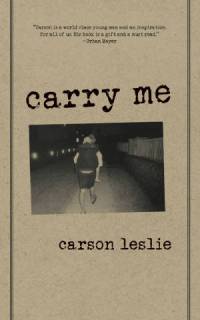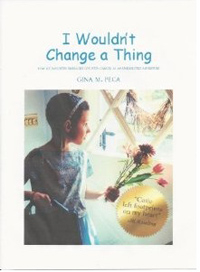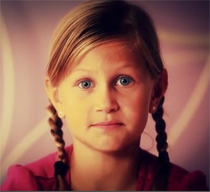
Editor’s Note: CAVATICA completed Beta testing and went live on October 17, 2016. This is a huge step in the right direction to eliminate silos of data and enter a new world of data sharing. The complete story can bed found here.
I have a rule that I follow—that if a parent who has lost a child to cancer needs a hand, I will find a way to pitch in—no matter what. Of course, life is busy, there are never enough hours in a day; however, those who are fighting to save the lives of children despite losing their own child are given high priority status. So when my friend (who I met via this blog) Amanda Haddock from Dragon Master Foundation asked if I would be interested in  attending the Children’s Brain Tumor Tissue Consortium (CBTTC) Annual Investigator/Foundation Meeting in New Orleans, saying yes to an excursion to the Big Easy was very easy. I figured I could go, take notes and write them up, and thus make a tangible contribution to a cause that I care so much about.
attending the Children’s Brain Tumor Tissue Consortium (CBTTC) Annual Investigator/Foundation Meeting in New Orleans, saying yes to an excursion to the Big Easy was very easy. I figured I could go, take notes and write them up, and thus make a tangible contribution to a cause that I care so much about.
I know so much about so many different types of cancers, but so little about brain cancer. My family has been hit by various adult cancers, but no brain tumors or childhood cancers to date—knock on wood. Little did I know how much I would learn at this meeting. I feel like I’ve gained more than I could possibly give back.
So, just briefly, the CBTTC is a collaborative research program led by leading pediatric brain cancer clinicians and researchers across 8 institutions, with The Children’s Hospital of Philadelphia (CHOP) as the coordinating center. I’ve included a 1-pager (click here), for those who are not familiar with the CBTTC research program and objectives.
The meeting captured a lot of heavy duty science—and I mean heavy, hard-core science—not only with respect to tumor biology and genomics, but also computer science and informatics. I’m sure almost everyone in the audience had some of those deer in the headlights moments, given the subject matter being presented at any given moment. Attendees included representatives from several non-profit foundations, neuroscientists and other laboratory/clinical scientists, pediatric neurooncologists responsible for day-to-day clinical care, and computing/informatics professionals. As someone with a background in oncology pharmacy, the computing/informatics part is most foreign to me, which is likely true for most clinicians and non-computer scientists who speak a very different language than computer scientists.
 In terms of my note-taking, there was so much technical information that I am in the “process of processing”. But in the meantime, I wanted to share with you – members of the childhood cancer awareness community – some of the big takeaways.
In terms of my note-taking, there was so much technical information that I am in the “process of processing”. But in the meantime, I wanted to share with you – members of the childhood cancer awareness community – some of the big takeaways.
First, unless you have been living under a biomedical rock, you are familiar with the VP Joe Biden-led Cancer Moonshot. If so, you have heard lots of talk about breaking down silos, collaboration, big data, genomics, immunotherapy, and precision medicine. Lots and lots of talk about share, Share, SHARE in the interest of accelerating cures and saving human lives from the devastation that often accompanies a cancer diagnosis.
Well, the bottom line is, that the CBTTC is already doing these Moonshot-esque things—and have been doing these things. This “sharing” is in no way a new concept for the  CBTTC. Not only are 8 institutions working together to break down those silos, they are more than happy to share, Share, SHARE their data with institutions outside of the CBTTC network. Their willingness and ability to do so stems from a genuine desire to save lives—save them while sparing them from the long-term and sometimes life-long toxicity of treatment regimens that are unlikely to help them, based on the characteristics of their own unique tumor biology. We can do things now, in the year 2016, that simply couldn’t be done before. On that note, while the CBTTC has been collecting high-quality biospecimens for several years, simply collecting tumor tissue isn’t enough from a saving lives standpoint. So they have not only been collecting tissue from all brain tumor types, but they have been linking that tissue to long-term clinical and genomic data. Then, by creating an open-access specimen and data informatics system, an environment for worldwide collaboration can be put into place. And it has been put into place already, with the introduction of CBTTC’s CAVATICA—a new cloud-based environment for securing storing, sharing, analyzing large volumes of pediatric brain tumor genomics data. CAVATICA is named after Charlotte A. Cavatica—the
CBTTC. Not only are 8 institutions working together to break down those silos, they are more than happy to share, Share, SHARE their data with institutions outside of the CBTTC network. Their willingness and ability to do so stems from a genuine desire to save lives—save them while sparing them from the long-term and sometimes life-long toxicity of treatment regimens that are unlikely to help them, based on the characteristics of their own unique tumor biology. We can do things now, in the year 2016, that simply couldn’t be done before. On that note, while the CBTTC has been collecting high-quality biospecimens for several years, simply collecting tumor tissue isn’t enough from a saving lives standpoint. So they have not only been collecting tissue from all brain tumor types, but they have been linking that tissue to long-term clinical and genomic data. Then, by creating an open-access specimen and data informatics system, an environment for worldwide collaboration can be put into place. And it has been put into place already, with the introduction of CBTTC’s CAVATICA—a new cloud-based environment for securing storing, sharing, analyzing large volumes of pediatric brain tumor genomics data. CAVATICA is named after Charlotte A. Cavatica—the  barn spider of the children’s story Charlotte’s web. It’s not puffery to say that real advances can and will come from this type of comprehensive genomics/clinical database. As I learned at the meeting, the CBTTC already has several commercial partnerships in place to develop what we might call “apps” to make sifting through such large volumes of data more user friendly. They have also partnered up with the Pacific Pediatric NeuroOncology Consortium (PNOC, network of 15 children’s hospitals that conduct clinical trials of new therapies), creating a critical bridge between science and clinical medicine. CAVATICA is so innovative and the partnerships in place are so very timely, fitting right into the Cancer Moonshot.
barn spider of the children’s story Charlotte’s web. It’s not puffery to say that real advances can and will come from this type of comprehensive genomics/clinical database. As I learned at the meeting, the CBTTC already has several commercial partnerships in place to develop what we might call “apps” to make sifting through such large volumes of data more user friendly. They have also partnered up with the Pacific Pediatric NeuroOncology Consortium (PNOC, network of 15 children’s hospitals that conduct clinical trials of new therapies), creating a critical bridge between science and clinical medicine. CAVATICA is so innovative and the partnerships in place are so very timely, fitting right into the Cancer Moonshot.
So takeaway 1 is really that the CBTTC is already doing what researchers should be doing in the interest of saving and improving human life, and that’s very inspiring.
Which leads me right to takeaway 2, which is critical for everyone to know and understand. CAVATICA may have started as a pediatric brain tumor database, but it is being developed to expand to any and all tumor types. This includes not only other types of childhood cancers, but also adult cancers. And this is a truly awesome thing, for reasons that may not be obvious on first blush. First of all, discoveries for children with brain cancer will be further accelerated by the ability to compare and contrast the genomic patterns in those tumor samples with those from other childhood and adult cancers. Without having those other cancers in the mix, critical patterns that can lead to new targets for treatment can be missed. Secondly, I hope that we can all agree that all patients with cancer deserve curative treatment, no matter what type of cancer or what age the patient is at diagnosis. All cancers represent some type of DNA damage. We should be able to reverse that damage, more effectively and user safer patient-specific therapies. Because I am all about “cures for all cancers”, I love the CAVATICA database and the vision behind its pioneers all the more. I believe that now is the time to break down the childhood vs adult cancer silos, so a big Thank You to the CBTTC for seeing the big picture in their big data plans and designing CAVATICA as something that we can all get behind.
Lastly, perhaps the most shocking takeaway for me is this: this high-tech effort, requiring intersection of various types of science and clinical medicine, has been and continues to be  funded in its entirely via donor support. Without the enthusiasm and generosity of the various non-profit foundations, CAVATICA would not exist. And it is not lost on me that children, many of whom have lost their lives, are the ones making this happen—these kids include Kortney Rose (age 9 when she passed away from brain cancer after 4.5 months), David (age 18 when he passed away from brain cancer after about 2 years), Christopher (age 7 when he passed
funded in its entirely via donor support. Without the enthusiasm and generosity of the various non-profit foundations, CAVATICA would not exist. And it is not lost on me that children, many of whom have lost their lives, are the ones making this happen—these kids include Kortney Rose (age 9 when she passed away from brain cancer after 4.5 months), David (age 18 when he passed away from brain cancer after about 2 years), Christopher (age 7 when he passed  away from brain cancer after 9 months), and Thea (diagnosed with brain cancer at 4 months of age and continuing her fight at age 9, having been in treatment almost her entire life), and so many other foundations, families, and donors who are stepping up to make the vision of the CBTTC a reality. I encourage everyone reading this to learn more about the CBTTC in particular and figure out ways to collaborate on the Cancer Moonshot in general—which is far more complex and for which far more is at stake relative to the regular “Moon” Moonshot. Whereas the moon is one big static thing, curing cancer will require precise rockets specific to millions of big and little people.
away from brain cancer after 9 months), and Thea (diagnosed with brain cancer at 4 months of age and continuing her fight at age 9, having been in treatment almost her entire life), and so many other foundations, families, and donors who are stepping up to make the vision of the CBTTC a reality. I encourage everyone reading this to learn more about the CBTTC in particular and figure out ways to collaborate on the Cancer Moonshot in general—which is far more complex and for which far more is at stake relative to the regular “Moon” Moonshot. Whereas the moon is one big static thing, curing cancer will require precise rockets specific to millions of big and little people.
Author: Laurie Orloski












